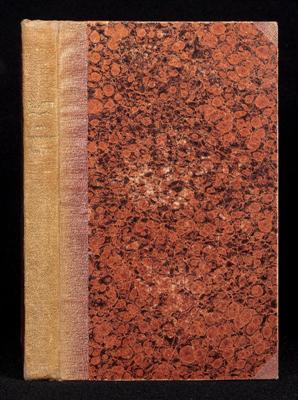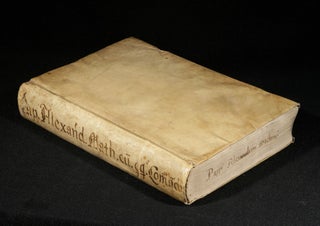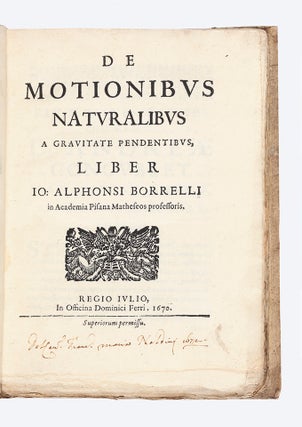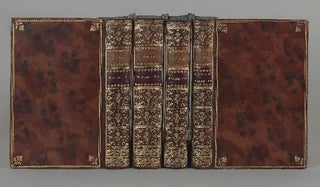Manuscript on paper, a copy of Jakugon’s Tō-Bongo sōtsuishū 唐梵語雙對集 [Collection with Corresponding Expressions in Chinese and Sanskrit], written throughout in black sumi ink with Siddham characters added in red. 35.5 folding leaves.
35.5 folding leaves. 8vo (246 x 168 mm.), orig. semi-stiff blue wrappers, new stitching. [Japan]: on final page (in trans.): “21 March 1735 copied by [name in four characters of Siddham], age 34.”
This a copy of a work otherwise known in Japanese as Tō-Bon ryōgo sōtsuishū 唐梵兩語雙對集 [Collection with Corresponding Expressions in the Two Languages of Chinese and Sanskrit], or in Chinese, Tang-Fan liangyu shuangdui ji, where the word translated as “Chinese” literally refers to the Tang empire. This vocabulary was written in 864 CE in China. It is ascribed to “a monk from central India” (WorldCat gives a name pronounced “Daduonieduobo” when read in modern standard Mandarin). The vocabulary is included in the Chinese tripitaka (Taishō canon).
Jakugon (1702-71) was a priest of the Shingon Sect of Buddhism serving at the Hotoji in Bicchu, Okayama Prefecture, but spent his later years at the Gyokusenji Temple in Kurashiki (also in Okayama). He deepened his knowledge of Buddhism and other studies by traveling widely, but concentrated on research in Sanskrit. He was also a famous calligrapher.
The vocabulary does not contain any original Sanskrit vocables in the sense of words written in Indic script. Rather, it lists Chinese words — mostly single-character expressions — with their Sanskrit equivalents transcribed in Chinese characters. All the expressions are also found in the better-known Fanyu zaming 梵語雜名 [Miscellaneous Nouns in the Sanskrit Language], alternatively known as Xitan ziyin 悉曇字引 [Guide to Siddham Characters]. Fanyu zaming might be the source used by the author of Tang-Fan liangyu shuangdui ji, a “dictionary of Sanskrit words for ritual practice, aimed at the beginner level, compiled in the Tang.”–Digital Dictionary of Buddhism. There is a logic to the order of the expressions. “Person” is listed first, followed by “flesh,” “skin,” “blood,” “bone,” “body hair,” and so on. Expressions belonging to other semantic fields follow.
In Tō-Bongo sōtsuishū, the Chinese characters used to represent the sound of the Sanskrit translations have all been transcribed according to their Sino-Japanese (onyomi) readings in katakana. In addition to the katakana gloss, Jakugon has added what we assume is Sanskrit, written in the Siddham script in red ink.
Jakugon’s addition of Siddham glosses to some of the words in the vocabulary reflects the popularity of this script within Japanese Buddhist circles in the Tokugawa period. Siddham is an Indic script that enjoyed relatively minor use in India but became the most studied Indic script within Chinese and Japanese Buddhism. It was transmitted to China in the Tang period and from there to Japan. Especially in China, but also in Japan, Siddham was primarily a kind of phonetic notation used to write Sanskrit sounds but not the Sanskrit language properly speaking. It was studied for the recitation of mantra and dharani in a pronunciation closer to the original. As a phonetic tool, it had a great influence on language use in Japan, as the arrangement of Siddham syllables influenced the traditional arrangement of Japanese kana in the “50 syllable chart” (gojūonzu 五十音圖). The study of Siddham enjoyed a revival in Tokugawa Japan, when the relationship to the “50 syllable chart” was recognized, and a limited study of Sanskrit grammar developed on the basis of words written in the Siddham script.
We know that Jakugon studied Siddham precisely in 1735. That year, he travelled to the Kansai region, where he learned Siddham from the monk Donjaku 曇寂 (1674-1742). Jakugon produced another work on Siddham in 1735, in addition to our work. We are unable to state whether our manuscript is in Jakugon’s hand or is a later copy (quite likely). If our manuscript is a copy, we assume it was traced by placing a thin sheet of paper over the original.
A fine fresh copy, preserved in a chitsu, which has a manuscript label on the upper cover in the hand of Senzo Mori, the chief bibliographer for Shigeo Sorimachi, the “H.P. Kraus” of Japanese books and manuscripts in the post-war period. With the seals of the Hotoji temple, Frank Hawley, and Shigeo Sorimachi’s company, Kobunso. Frank Hawley was a scholar and one of the most discerning collectors of Japanese books and manuscripts. See R.H. van Gulik’s “In Memoriam. Frank Hawley (1906-1961)” in Monumenta Nipponica, Vol. 16, No. 3/4 (Oct. 1960-Jan. 1961), pp. 434-47.
Price: $5,500.00
Item ID: 9017

![Item ID: 9017 Manuscript on paper, a copy of Jakugon’s Tō-Bongo sōtsuishū 唐梵語雙對集 [Collection with Corresponding Expressions in Chinese and Sanskrit], written throughout in black sumi ink with Siddham characters added in red. 35.5 folding leaves. JAKUGON 寂嚴.](https://jonathanahill.cdn.bibliopolis.com/pictures/9017.jpg?width=768&height=1000&fit=bounds&auto=webp&v=1681747348)
![Manuscript on paper, a copy of Jakugon’s Tō-Bongo sōtsuishū 唐梵語雙對集 [Collection with Corresponding Expressions in Chinese and Sanskrit], written throughout in black sumi ink with Siddham characters added in red. 35.5 folding leaves.](https://jonathanahill.cdn.bibliopolis.com/pictures/9017_2.jpg?width=320&height=427&fit=bounds&auto=webp&v=1681747348)



